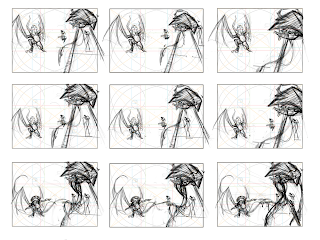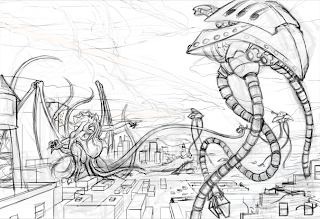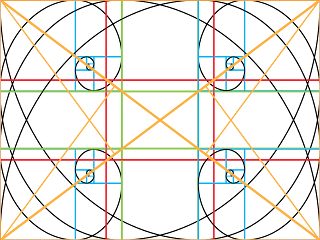News and updates about my artwork, tutorials, thoughts and other cool stuff.
Tuesday, March 26, 2013
The Art of Critiquing
There is an art to the critique, but over the years I have learned that most people have many misconceptions of how a critique should be given or received. It took me a while to learn the art of a good critique, but over many years of school and critiquing sessions, I felt it would be a good idea to share what I have learned. Lastly, it is my intent for this article to be able to work for any medium whether it be the visual arts, music, writing, culinary, performing arts or even a worker's performance in day to day life.
So, what should a critique be? This might seem like a silly question, but I have found that many people confuse a critique with a criticism. This leads many critiques to often tear down the person receiving the critique, when in fact they wanted some constructive feedback so that they can improve. When someone asks for a critique, they are either asking for a pat on the back, how they can improve or a bit of both. Over the decades it has long been debated in our school system whether it is better to use negative or positive reinforcement. The truth of the matter is that both methods have their merits, but alone they can cause damage. Keeping this in mind, when giving a critique, it is best to give both the pros and the cons. Focusing just on the positive can make the recipient misunderstand the intent of the critique such as: the artist thinks he/she is a professional level artist or that the critic is being insincere. Equally if the critique focuses just on the negative then that artist might end up changing something that was good, especially if there were a lot of negative points, or that artist might even give up all together because of feeling a loss of worth.
A better approach to a critique, is to apply both positive and negative reinforcement. With this approach, the person receiving the critique will be more receptive to the areas that need improvement and in a addition they are more likely to keep the aspects of their work that were successful. Some might argue that this is to avoid hurt feelings, but this is not the case, it is about good communication between the critic and the receiver which in turn will lead to a positive outcome.
There are somethings that a critic should and should not do. A critic should not try to point out a problem if they have no knowledge or experience in that given area, because this will provide bad feedback for the person on the receiving end of the critique. If the critic does detect a problem through intuition, but it is beyond their experience then stating the problem area is acceptable, but it must be pointed out that he/she doesn't have the exact knowledge of what is wrong. If the critic is not only an expert, but is skilled as well, then the critic should explain how to correct what is pointed out. Such an explanation is a courtesy, but is more constructive than without. The critic, however should not be obligated as to the length of such an explanation, if the critic feels any explanation is needed. It is good form to provide additional explanation or help if the receiver requests such information, but again this is not an obligation.
While I have stated that a balanced critique is one that provides both positive and negative feedback, sometimes this is harder said than done. If as the critic, you can't find any positive thing to say about the receiver's technique and skill, then pointing out the concept of what they were trying to achieve in a positive light can help. If the receiver shows they made a lot of effort in the work they did, then acknowledging that effort can help. If as the critic you can't find any negative feedback then try following up with alternative ideas that fit within the intent of the receiver's work because this might inspire them to reach higher than their current ability.
The receiver of a critique also needs to understand how to receive a critique with grace. First the receiver should keep quite until the critique is finished and to not be quick to defend. In fact, the receiver should not try to defend their work at all, because most of the time they asked for the critique. After the critique is given the receiver may and probably should explain what their intent was in the work that is up for critique. Sometimes this may be given before a critique and it really depends on the protocol that has been established in a session. When the intent is communicated then the critic will understand better and will offer better feedback. This is often needed because the intent is not always apparent. It is good to get critiques from different sources for the same work, because if there are overlapping comments then odds are good that they know what they are talking about. If the receiver feels that the critic is in error then that is fine, but it is bad form to call them out. If the critique is given online then it is fine to check out their work if the receiver needs that validation if the all or part of the critique was thought to be in error due to non-experience; don't accept the talk if they can't walk the walk.
Remember, a critique is not about criticizing, but it is about communication and constructive feedback to help the receiver of the critique improve their skills and knowledge. Hopefully I have covered what makes a good and balanced critique, but life can always throw you a surprise, so please feel free to ask any questions you may have and I will answer it to the best of my ability.
Friday, March 22, 2013
Arkham: A nice place to Visit: My process
Ever since Mike Davis was kind enough to show my War of the Worlds Vs Cthulhu composition on his website Lovecraft Ezine and on his corresponding Facebook Page it has been getting more coverage than I have ever had before. So I thought it would be a good idea to share a little bit about the process I took in creating it as well as my other art.
However, before I get to my process I will share a detail that doesn't show up well on the versions that I have up on the internet for viewing. First there is a lot more detail to Cthulhu and second is the billboard advertisement for the fictional Arkham City. While this doesn't show up in most of the web versions, it does show up well on a full size print which can be bought through Zazzle or Deviant Art which you can get to via the page tabs above.



The first step I took when planning this composition is working up some quick thumbnail sketches in Photoshop. The ratio size of these thumbnail sketches are in direct proportion to the size of the canvas that I desired for the final piece. I already had a good idea of what I wanted, because I had visualized it in a dream, so the changes are minor in the variations for these thumbs, but often this process is a brain storming session, because while at times I might have started off with a small seed of an idea, thumbing may allow it to grow into anything. Mostly what I was looking for was positioning and poses for the primary and secondary foci of this composition. To help me with placement I used my golden ratio overlay tools. You can find out more about that on my Golden-Compositions post. After finding the general positioning and poses that I like, I then add in more content with a few more thumbnails for a more complete composition.
 After I choose the final thumbnail sketch I scale this rough sketch up to a large size canvas and refine the sketch more. During this sketch I am looking for a tighter drawing so my concerns are about proper perspective and form since I don't have to worry about the compositional placement anymore. I also add in more details, but I keep these details loose because I don't want to obsess about it; this is a easy trap to fall into and I try to avoid it at all costs. I sketch right into Photoshop via my Wacom tablet and I do so on a transparent layer because this allows me to paint underneath my sketch so that I can keep my drawing separate from my painting, because the last thing you want to do is be destructive to the work you have already done.
After I choose the final thumbnail sketch I scale this rough sketch up to a large size canvas and refine the sketch more. During this sketch I am looking for a tighter drawing so my concerns are about proper perspective and form since I don't have to worry about the compositional placement anymore. I also add in more details, but I keep these details loose because I don't want to obsess about it; this is a easy trap to fall into and I try to avoid it at all costs. I sketch right into Photoshop via my Wacom tablet and I do so on a transparent layer because this allows me to paint underneath my sketch so that I can keep my drawing separate from my painting, because the last thing you want to do is be destructive to the work you have already done.
Painting now begins and I start off lowering the opacity of my sketch to around 30% and then lock the layer. I then create a new layer under this and begin painting the local colors I want for all my objects. Sometimes, I will go back and change this as needed. Your local colors are the true color of your objects but they will be effected by the temperature of light and shadow later and so will look very different later on. The only exception I made here was the sky. When I paint skies I just let my intuition take over and taking logic out of the process because doing skies I find to be an abstract experience.

When finished with that I lock my local color layer and then create two new layers over this to start working in light and shadow. One layer is set to multiply at a lower opacity and soft light on the other. To know more about this process you can check out this other article I wrote called color-blending-fx-brushing-and-photos which not only explains the process but also includes video tutorials I have created.

Now that I have color and value down close to what I want, I create merged copy layer of what I have created so far and paint directly on that; this way my canvas becomes my pallet and I don't have to worry about using color swatches. I then clean up and make alteration to color as I think it needs it. I also starting laying in some base texture as a starting point for texture and details. I use these textures merely as a starting point and guide and I paint over this to fit the painting. If you would like to know more about textures then you might check out my texture-hunter part 1.
My last step is to bring the painting home, which generally means that I continue painting in refinements, textures and details. The very last effort I made on this painting was to make one more merged copy of the work I had so far and rotated the image a few degrees for a dutch angle to create some mood but the reason I only did this a little bit because I didn't want to throw my compositional placement off. If I find that I cannot figure out what more to do or if I am getting fussy over the painting I walk away from the painting for several hours and then come back to it with fresh eyes.
So I hope you found this interesting and helpful and would be glad to answer any questions so feel free to ask them in the comment box.
Sunday, March 3, 2013
Golden Compositions
Golden Compositions
Most artists have heard of the golden ratio or rule of two-thirds, but not every artist know all the different variations let alone how to use such mathematical tools. In this article I will go over these various tools of Phi and my interpretation on how to and when to use them. Also for the digital artists I have included these files to be transparent PNGs that can easily be adjusted to the area of what ever size canvas you may be working on because when stretch or squashed it will keep the ratio in relation to your canvas, allowing for a quick compositional grid overlay.
The Golden Ratio
The golden ratio is is a grid divided into thirds, with the middle rows being half the size of one of the out rows but when the outer rows are added to the middle then the total length and width are attained in a balanced mathematical proportion with a ratio of 1.68. To use this grid in art, one simply needs to place the focal point of their composition on and around one or more of the intersections of the grid. Another option is to the columns for placement. If one used the center then one can create a power focus but such focus needed only when the subject is overwhelm the audience. For instance the statue of liberty or the Monolith from 2001 space Odyssey.
The Rule of Two-Thirds
This is the cousin of the Golden Ratio and it is used exactly the same way with just a little different placement as the area of the piece is divided equally into thirds.
The Golden Triangle
The Golden Triangle is a little different than the ratios and the point of using this tool is for directional line or for placement that breaks up the piece into thirds. If used for directional line the focal points line up and the intersection and spread out but for placing the images into thirds then one to two of the triangles will contain your focal points but it is best to do this on separate planes.
The Golden Spiral
The bottom one is the one with the transparency
The Golden Spiral is about placement and flow of the picture to help guide the eye of the viewer around the picture plane. This is a powerful grid and it is a form of fractal that can be found all through out nature. From studying various strong compositions and other articles about this tool I can tell you that it is the hardest one to follow, but I hope my understanding will make it clear you you all. The grid itself is based on the golden ratio but it can definitely spiral tighter and tighter and it keeps breaking down . Inside these sections you can place your main focal points of your composition as long as they remain for the most part of the inside track of the spiral that is formed from the cornered points. Secondary focal points can be created by placing them as an intersection along this spiral path which will create flow and guide the eye around your composition.
Down Below are examples of my artwork that show how these grids work for strong compositions.
Also it is important to note that you don't have to limit your self to just one of these tools or the multiple use of the same tool but with different orientation with the only proviso that you do not distort the ratios.
I have included one more transparent ratio grid and that is a master grid that gives all possible orientation, but I would advise starting off with these separately until you understand how they work before trying to use them all at once.
Lastly if you have any questions please feel to ask and I will answer them the best I can. Also I don't claim total knowledge in how the golden ratio can be used and I feel that there are many different methods in using it so if you know something I don't then please share with a comment.
Subscribe to:
Comments (Atom)
















